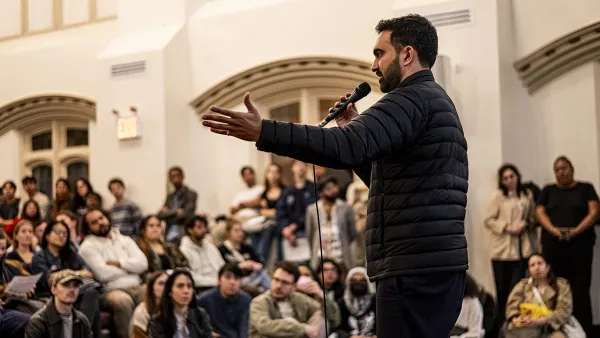Sam Hall Kaplan elucidates the inadequacies of affordable housing policy before introducing a new perspective to the conversation—a new book by Roger Katan with Ronald Shiffman called "Building Together."

"Affordable housing," the intensifying need for it, however broadly priced and defined, has become the latest planning and political shibboleth. It is resounding particularly loudly these political querulous times in the rapacious development realms of New York and Los Angeles, and echoing most everywhere in the increasingly dissolute urbanized world.
For anyone concerned with basic shelter, whether mulling over the latest academic studies, listening to neighborhood prattle, or scanning real estate offerings, the dearth of reasonable choices and the escalating prices are daunting, aggravated by the corresponding creep and curse of income disparity. For low-income persons the situation is desperate, for the moderate, challenging, and the middle income, worrisome.
Exclaiming the escalating price of housing, one of "most profound challenges" facing New York City, Mayor Bill de Blasio called for an ambitious, all-inclusive construction program. "If we fail to be a city for everyone, we risk losing what makes New York, New York. We risk losing the very soul of this place," he declared, adding "nothing more clearly expresses the inequality gap—the opportunity gap—than the soaring cost of housing."
Critical to the wishful program would be increasing the allowable density of select neighborhoods to stimulate market rate projects that include an acceptable percentage of affordable units.
This popular trickle-down development theory championed by ostensible good government groups has had limited success in the city’s avaricious past, when private greed tended to out maneuver public intent. The mayor and his stolid staff extolling a populist creed are promising 160,00 new units; the misanthropic media concerned with civic ventures opines maybe 16,000, in the distant future. Commensurate would be an effort to curb gentrification and protect the city's dwindling stock of affordable housing.
In Los Angeles, the situation is actually considered worse, at least according to a recent report by the Harvard University’s Joint Center for Housing, which declared the city to have the least affordable rental market in the country. An enigmatic Mayor Eric Garcetti and his ingenuous staff sheepishly smile.
Not so the Los Angeles Times, which in a welcome foray into gutsy local issues chastised the city for doing little to address the need. "It is not for a lack of ideas," declared an editorial, but rather "a lack of focus and political will." Chirping in reply for a distracted mayor, the city's planning department pointed to proposed changes in zoning for select large projects to allow them higher density in exchange for more affordable housing.
The gesture is being criticized by activist community planners and also several of the city's planning commissioners as a West Coast version of the East Coast trickle-down theory, primarily benefitting private development, and mimicking the pap and patrimony of New York's ballyhooed Bloomberg era.
Enough of these sweeping sham proposals and their media moments, activists are declaring. It is time for programs that speak to the need at a scale and sensitivity that the people in target communities can relate to; programs, beyond the empty political rhetoric of concern and that have faint hope of creating something more than an academic cant and seldom-read studies.
Actually these appeals have been echoing for years, though outside the bureaucratic chambers and obfuscating conferences of the lockstep planning rank and file. At best they have been given a condescending nod, though mostly they have been arbitrarily and unfortunately dismissed. Out of frustration, activist planners and community organizers do tend to be shrill and strident.
But the faithful persist, and are actually gaining traction in the wake of the pressing need for affordable housing and the resentment stirred by the increasingly obscene income disparity. At long last, the time just may be ripe for a needed burst of veracious community planning.
Entering the fray is a providential new and needed book, titled Building Together, by Roger Katan with Ronald Shiffman, two prominent community planners, illustrating how cities should and could evolve to be more democratic and livable. Published by the New Village Press, a welcomed non-profit division of the enduring Architects/Designers/Planners for Social Responsibility, the book is a craggy compilation of varied case studies in participatory planning and community building the authors have been involved with, around the globe but mostly in New York, over a half century.
To me Katan's dogged efforts in East Harlem to integrate community services with critically needed, more resident-friendly low income housing is particularly affecting, for at the time in the early '60s I actually was living in the community and was not incidentally the vice chairman of the local planning board. I also had the additional arrow in my quiver of being the editor of the East Harlem Independent newspaper. This makes me unabashedly prejudiced.
As Katan notes, efforts by him and other planning activists to get the city to be more sensitive to East Harlem's myriad needs was a constant, exhausting battle, let alone just getting some bureaucrats to leave their desks downtown to come uptown to meet and listen to their requests. And as for the residents, it was hard enough for them to survive day to day, and then also have to find the time to organize and confront what we labeled the "civil serpents."
Living in a predominately low-income neighborhood frankly relegates residents to a second-class citizenry, and makes planning that much harder. That in turn makes the need for sensitive advocacy planning as practiced and preached by Katan and Shiffman such a challenge, and so praiseworthy and critical.
They worry with good reason that "bureaucratic systems depersonalize relations and devitalize situations, for when social problems are analyzed abstractly and solutions expressed on paper, all personal and familial substance disappears." To really comprehend planning you must walk down a city’s mean streets, as the authors did, and become site specific. Sweeping plans just don't cut it in the hood.
With that in mind, Katan raises important questions about the role of universities in the community, clearly showing his prejudice for students to become more actively involved in grass roots efforts. Also challenged are the comfortable professionals catering to the powers-that-be and their pocketbooks, and the inured academics constructing sinecures.
The purpose of the book, declare the authors, "is to give a new generation of community activists, architects, planners and decision makers insight into the importance and significance of integrating action and place," and engaging people to shape a more civil society.
Hope springs eternal, with the authors concluding that "as long as the interests of minorities, the less powerful, and future generations are taken into consideration and respected, successful planning is possible." Amen.
Sam Hall Kaplan is a venerable planner, writer and academic persevering in Los Angeles. A former urban affairs reporter for The New York Times and design critic for the Los Angeles Times, he also writes for The Planning Report and The Architect's Newspaper.

Planetizen Federal Action Tracker
A weekly monitor of how Trump’s orders and actions are impacting planners and planning in America.

Chicago’s Ghost Rails
Just beneath the surface of the modern city lie the remnants of its expansive early 20th-century streetcar system.

San Antonio and Austin are Fusing Into one Massive Megaregion
The region spanning the two central Texas cities is growing fast, posing challenges for local infrastructure and water supplies.

Since Zion's Shuttles Went Electric “The Smog is Gone”
Visitors to Zion National Park can enjoy the canyon via the nation’s first fully electric park shuttle system.

Trump Distributing DOT Safety Funds at 1/10 Rate of Biden
Funds for Safe Streets and other transportation safety and equity programs are being held up by administrative reviews and conflicts with the Trump administration’s priorities.

German Cities Subsidize Taxis for Women Amid Wave of Violence
Free or low-cost taxi rides can help women navigate cities more safely, but critics say the programs don't address the root causes of violence against women.
Urban Design for Planners 1: Software Tools
This six-course series explores essential urban design concepts using open source software and equips planners with the tools they need to participate fully in the urban design process.
Planning for Universal Design
Learn the tools for implementing Universal Design in planning regulations.
planning NEXT
Appalachian Highlands Housing Partners
Mpact (founded as Rail~Volution)
City of Camden Redevelopment Agency
City of Astoria
City of Portland
City of Laramie





























